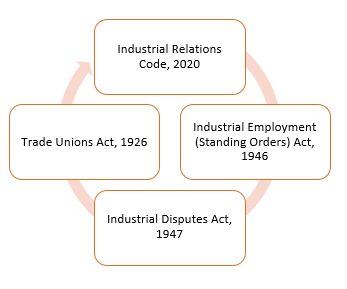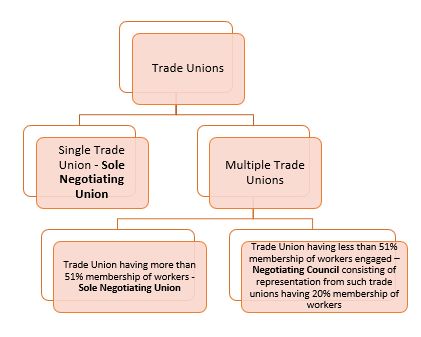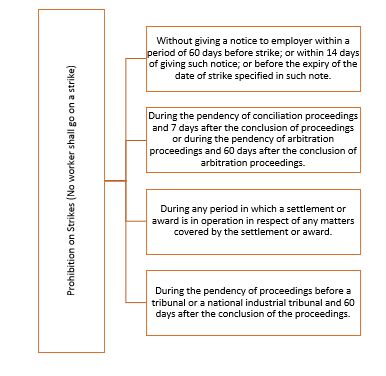- within Litigation, Mediation & Arbitration and Finance and Banking topic(s)
- with readers working within the Law Firm industries
I. INTRODUCTION
The Industrial Relations Code, 2020 ("Code") is the concluding code in our 4-part series on the new labour legislation. This note will provide a comprehensive analysis of the Code. The Code aims to develop and maintain harmonious and healthy relations between workers and employers in an industrial establishment by minimising the scope for illegal strikes and lockouts, penalising unfair labour practices, providing better working conditions to workers, and an efficient dispute settlement and grievance resolution mechanism. The Code shall integrate 3 existing labour law legislations into the Code.

II. COVERAGE AND APPLICABILITY
The Code shall apply to all employees including supervisory, managerial, and administrative staff that were previously not a part of the Industrial Disputes Act, 1947 ("ID Act") and employers including contractors and legal representatives of a deceased employer.
The provisions of the Code shall also apply to industries which include most enterprises for production, supply, and distribution of goods. It however, excludes charitable organisations, sovereign functions of the Government and domestic workers.
III. DEFINITION OF 'WORKER'
Under the Code, the definition of 'worker' shall include the definition of 'workman' under the ID Act and shall also extend to (a) working journalists1; and (b) sales promotion employees2. As per the ID Act, the definition of 'workman', excludes persons employed in a supervisory capacity and drawing wages more than INR 1,600 per month. Under the Code, this amount has been increased to INR 18,000.
IV. FIXED TERM EMPLOYMENT
The Code shall introduce a new provision for 'fixed term employment', where a worker is employed for a fixed time period based on a written contract. This concept aims to protect the rights of fixed-term workers by providing them with the same benefits offered to permanent employees. Benefits such as wages, allowances, gratuity, and other statutory benefits for both fixed and permanent employees should be on par with each other. Fixed-term workers shall be eligible for gratuity if they render service under the contract for a period of 1 year.
As per the Code, termination of service of the worker as a result of the completion of tenure for fixed-term employment would not result in retrenchment. Further, as per the First Schedule of the Code, the classification of employees as fixed-term employees would require standing orders under this Code.
V. GRIEVANCE REDRESSAL COMMITTEE
For setting up of grievance redressal committee ("Committee"), the Code has reduced the minimum number of workers employed in an establishment to 20, from 50 under the ID Act. Such Committee shall consist of an equal number of members representing the employer and the workers, chosen in a manner as may be prescribed under the Code or the central or state rules. The total number of members in the Committee shall not exceed 10.
Unlike the composition established under the ID Act, the Code has ensured an adequate representation of women workers in the Committee, where such representation shall not be less than the proportion of women workers to the total workers in an establishment.
In case any dispute arises in an industrial establishment, the aggrieved worker should file an application in respect of the dispute before the Committee within 1 year from the date on which the cause of action for the dispute arises. The proceedings shall be completed by the Committee within 30 days from the date of the application. In case, the aggrieved worker is not satisfied with the decision of the Committee, then such worker can file an application for the conciliation of such grievance to the conciliation officer through the trade union, of which he is a member, within 60 days from the date of the decision.
VI. RECOGNITION OF NEGOTIATING UNION OR NEGOTIATING COUNCIL
The Trade Unions Act, 1926 has laid down the provisions regarding registration of trade unions, appointment of registrars, cancellation of registration, rights and liabilities of a registered trade union, etc. All these provisions have been incorporated under the Code. In addition to this, the Code provides for a single negotiating union/council (even in cases of multiple trade unions) in an industrial establishment having a registered trade union for negotiating on such matters as may be prescribed in the Code.

VII. STANDING ORDERS
Standing Orders are orders to be prepared by the employer relating to matters mentioned in the First Schedule of the Code such as classification of workers, working hours, attendance, suspension, termination, etc., which generally governs the relationship between the employer and a workman in an industrial establishment.
Although the Industrial Employment (Standing Orders) Act, 1946, applies to every industrial establishment where 100 or more workmen are employed, the Code has increased the number to 300 workers.
Central Government is required to make model standing orders in relation to conditions of service and related matters. The employer is expected to prepare draft standing orders within a period of 6 months from the commencement of the Code, based on the model standing order. If the employer adopts a model standing order of the Central Government, then such model standing order shall be deemed to have been certified and the employer shall forward the information in this regard to the concerned certifying officer in the manner as may be prescribed.
The Industrial Employment (Standing Orders) Act, 1946 does not have a provision for time limit for completing the disciplinary proceedings against the employee. The Code on the other hand provides that, where any worker is suspended by the employer pending investigation or inquiry into complaints or charges of misconduct against him, such investigation or inquiry, shall be completed within a period of 90 days from the date of suspension.
VIII. STRIKES AND LOCK-OUTS
The definition of 'strike' under the Code is similar to the definition under the ID Act. In addition to the existing definition, the Code specifically includes the concerted casual leave on a given day by 50% or more workers employed in an industry.
As per the ID Act, the provisions for strikes and lock-outs were only applicable to public utility services under the ID Act, however, the Code shall apply to all industrial establishments. The provisions on prohibitions of strikes and lock-outs in the Code have been listed below.

The date of strike should be within the 60 days' time frame of issue of notice, beyond which a new notice will need to be served. The date of the strike must not be within 14 days from the date of the notice. No employer of an industrial establishment shall lock out any of the workers unless the conditions mentioned in the diagram above are met.
IX. LAY-OFF, RETRENCHMENT AND CLOSURE
Non-seasonal industrial establishments employing 50 to 300 workers are required to pay to every worker who has completed at least 1 year of continuous service: (i) 50% of basic wages and dearness allowance to the laid-off worker; and (ii) give 1 months' notice (or pay wages in lieu of notice) to the retrenched worker along with 15 days' wages for every completed year of continuous service. The rules for lay-offs, retrenchment, or closure under the Code shall not apply to establishments employing less than 50 workers or is seasonal or intermittent in nature,
Under the ID Act, non-seasonal industrial establishments with more than 100 workers employed are required to obtain prior permission from the appropriate Government to lay-off / retrench workers as well as in cases of closure of an industrial undertaking. The Code has retained this requirement for non-seasonal industrial establishments such as mines, factories, and plantations employing not less than 300 workers, or such higher number as may be notified by the Government. However, this requirement is not mandatory in a case where a lay-off is due to a shortage of power, or natural calamity, and in case of a mine, the lay-off is due to fire, flood, excess of inflammable gas, or explosion. In such cases, it shall be the responsibility of the employer to make sure that the worker is given alternative employment to work on.
If the Government does not intimate the order granting or refusing to grant permission to the employer to lay off / retrench workers within a period of 60 days from the date of application, the permission shall be deemed to have been granted.
X. WORKER RE-SKILLING FUND
The Code has introduced provisions for re-skilling of workers who have been laid-off by setting up the Worker Re-skilling Fund ("Fund"), which will enable such workers to secure employment again. The contributions to the Fund shall consist of the following:
- from the employer of an industrial establishment, for an amount equal to 15 days wages last drawn by the worker immediately before the retrenchment, or such number of days as may be notified by the Central Government, for every retrenched worker in case of retrenchment only; and
- from such other sources as may be prescribed by the appropriate Government.
The Fund shall be utilised by crediting 15 days' wages last drawn by the retrenched worker to his account, within 45 days of retrenchment in the manner as prescribed under the Code.
XICONSTITUTION OF INDUSTRIAL TRIBUNALS
The Code provides for the constitution of one or more industrial tribunals and a national industrial tribunal to adjudicate industrial disputes. Every industrial tribunal shall consist of 2 members: (i) a judicial member; and (ii) an administrative member, who shall be appointed by the appropriate Government. Under the ID Act, every industrial tribunal had only 1 member to be appointed by the appropriate Government.
Under the Code, the Central Government may by notification, constitute 1 or more national industrial tribunals for the adjudication of industrial disputes, which in the opinion of the Central Government, involve questions of national importance or of such a nature that industrial establishments situated in more than one state are likely to be interested in, or affected by, such disputes.
The national industrial tribunal shall consist of 2 members to be appointed by the Central Government, as opposed to 1 member under the ID Act. The cases pending before the commencement of the Code in the labour court and the national tribunal constituted under the ID Act shall be transferred to the tribunal or the national industrial tribunal having corresponding jurisdiction under the Code. Such cases shall be dealt with from the start or from the stage at which they were pending before such transfer, as per the discretion of the tribunals.
XII. PENALTY
Any person who contravenes any provision of the Code or the rules or regulations framed under the Code shall be punishable with a fine which may extend to INR 1,00,000. The Code also enables compounding of offences which are penalised with a fine, or imprisonment of up to 1 year.
Footnotes
1. Defined in Section 2(t) of the Working Journalists and other Newspaper Employees (Conditions of Service) and Miscellaneous Provisions Act, 1955.
2. Defined in Section 2(d) of the Sales Promotion Employees (Conditions of Service) Act, 1976.
The content of this article is intended to provide a general guide to the subject matter. Specialist advice should be sought about your specific circumstances.



